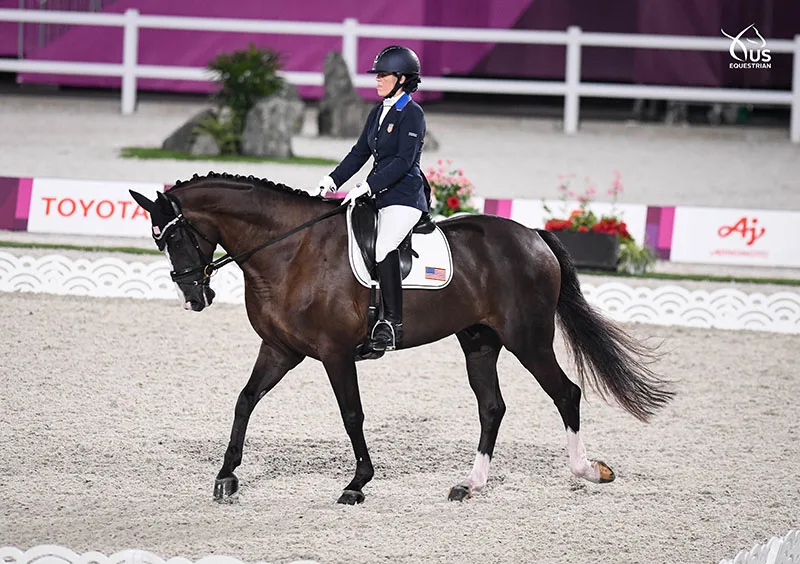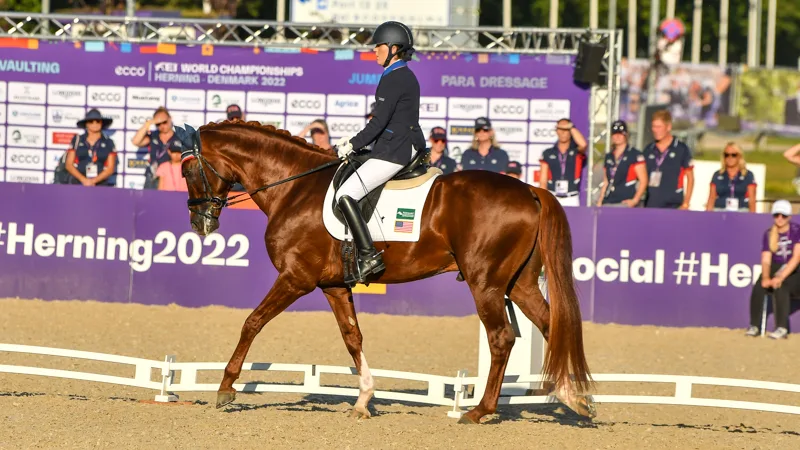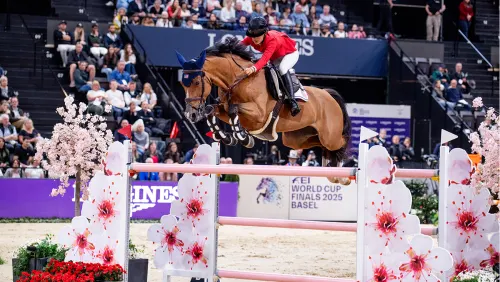Roughly a year out from the Paris Paralympics, the top medal-winner from the U.S. para dressage team in Tokyo is doing a lot of driving.
Roxanne Trunnell, who won two individual gold medals—setting a Paralympic record high score with a 86.92% freestyle along the way—and team bronze aboard Karin Flint’s Dolton in Tokyo in 2021, is dividing her time among three horses at different barns. Two of the three are part of her double-down strategy to ensure she sets herself up for a return trip to the next Paralympics.
One of the challenges in that process is the fact that Dolton, the 11-year-old Hanoverian gelding (Danone I—Lady, Londonderry) who has proven himself nearly unbeatable in international para-dressage, has been out of action since March 2021 when he injured himself in the stabling at the Adequan Global Dressage Festival showgrounds in Wellington, Florida.

“It had nothing to do with the stall itself,” Trunnell said. “It was just a big horse being stupid, and he ended up hurting himself. So we have been rehabbing him, and he has been doing fantastic.”
He’s back to work under saddle now, his own potential Paralympic return trip starting from his home farm in Wellington. And although Trunnell has yet to sit on Dolton since his accident, she has put regular time into maintaining their relationship from the ground and is confident that effort will pay off in the arena.
“Even though I am not riding him, I do go out to his stable almost every day in order to give him his treats and to spend time with him,” said Trunnell, 38. “That has kept our bond alive. Once I get in the show ring again, the magic is still going to be there because of the complete trust we have in each other.”
When Dolton was injured in the run-up to the 2022 Orifarm Healthcare FEI Para-Dressage World Championships (Denmark), Trunnell found a new partner in a somewhat unlikely package: Lehua Custer’s eye-catching Oldenburg stallion Fortunato H20 (learn more about him here), just 6 at the time and with no previous para-dressage experience. “Tuna” (Floriscount—Raleska WF, Rascalino) stepped in at the eleventh hour, and with Trunnell won every class the pair entered on U.S. soil to become her ticket to Denmark.
“People probably thought we were crazy since I hadn’t been riding Tuna for long, and he was a young stallion,” Trunnell said. “But he behaved beautifully and ended up helping the team to a bronze medal and securing a spot in the 2024 Paralympics!”

After a strong start to their 2023 season—the pair again went undefeated in Grade I CPEDI competition in Wellington—they traveled to Europe earlier this month to participate in the CPEDI3* Peelbergen (the Netherlands), June 15-18, where they gained more overseas experience against stiff competition including 2022 FEI World Championship Grade I gold medalists Rihards Snikus (Lithuania) and King Of The Dance. There, they finished second, fourth and sixth with scores above 70% in all three of their classes.
In addition to spending time with Tuna and Dolton, Trunnell also can be found riding her own 28-year-old mare Nice Touch. Between training Tuna, riding “Touché,” and visiting Dolton, Trunnell’s days are spent zipping to and from Loxahatchee and Wellington to make sure she fits in all three horses.
ADVERTISEMENT
We caught up with Trunnell to get an update on Dolton, her plans for this summer, and her hopes going forward.
What has Dolton’s rehabilitation looked like so far?
I haven’t actually been riding him myself, but my trainer [Andrea Woodard] has been. She is able to walk, trot, canter on him, unlike I am able to do, and that is what he needs to build up his muscles so that he doesn’t re-hurt himself.
I am so glad that Karin Flint has given him the time he needed to heal properly. Yes, he is a double gold medal-winning horse, but he is far too special of a horse to risk his health or his career by putting him back into a show setting before he was ready.
Are you doing anything other than showing while you’re across the pond?
My mindset is that this is kind of my job, and so I go there to do well and not to get distracted by sightseeing and visiting with people. I’m a boring travel buddy. When I go to a show, I kind of get blinders on: I go to the showgrounds and back to the hotel.
I won’t be horse shopping over there. Lehua Custer has agreed to have me qualify Tuna for the Paralympics, and then to [let me] take him if we need to, but after that she is going to want her horse back. There has been talk about what to do for a second horse after we no longer have Tuna, but there have not been any definite plans to find another horse as of right now.
What does the year ahead look like for you in the run-up to Paris?
Lots and lots of training! I’m planning to qualify both Tuna and Dolton for the 2024 Paralympics. Dolton will be my main horse, but if anything goes wrong, we will have Tuna to fall back on as a backup horse. The scramble to find me a horse for the 2022 world championships isn’t something I think any of us want to experience again, so we are being prepared this time.
You moved away from your hometown of Kennewick, Washington, for the first time almost 10 years ago. What factored into that decision, and why did you decide to bring Touché with you?
We moved to Texas first right before the 2014 WEG because there were no para-dressage trainers around where we lived in Washington.
ADVERTISEMENT
I actually took Touché to the 2014 WEG in Normandy. That was kind of her swan song in the dressage ring, since I told her in France that if she got me through my first international competition that I would never make her go down centerline with me again. She ended up being the best horse on the USA team, so keeping to the promise I made her, I semi-retired her once the show was over.
Then right before the 2018 WEG I was given the opportunity to ride Dolton, but it came with a few challenges: He would have to stay in Florida, and I would have to train with Andrea Woodard, who trained Kate Shoemaker [Dolton’s owner at the time]. That was a hard decision to make, but it turned out to be the right decision.

It was never really a question that Touché would go with us. I really owe the reason I ride as well as I do to that mare! She is very high-spirited, and I can’t count how many times she put me in the dirt when I was an able-bodied rider, but once she saw me in a wheelchair she became a wonderful para horse. It’s like our bond is so strong she is determined to take care of me just like I was her foal.
You shared on social media that you recently got some new ink, the phrase “pat your horse” on your right forearm. Why is that sentiment important to you?
When I first started riding, all my past able-bodied trainers had drilled into my head that the horse doesn’t have to let you ride them, and to always be kind to them because they are doing you a favor. Horses don’t go into a test thinking about letting their riders down; they don’t think like that.
There’s always something positive about a ride, and to not reward your horse with a simple pat is just plain mean and wrong. The sad thing about this is I continue to see this behavior with able-bodied and para-equestrian dressage riders, so I got the phrase “pat your horse” tattooed and placed where it is visible to kind of remind other riders to do this.
Your most recent addition isn’t the only equestrian-related ink you have. What is the significance of a few of your other tattoos?
When I was 18 I decided that if the horses I’m showing have to get branded, then I was going to get branded as well, so I have the Dutch Warmblood brand on my lower back, the Hanoverian and American Warmblood brands on both sides of the inside of my left wrist, and the Oldenburg and Westphalian warmblood brands on the outside forearm of my right arm.
Then I got the crazy ideal at the 2018 WEG that if I medaled, I’d tattoo the show on my body. And then I kept that going for the 2020 Paralympics and the 2022 World Championships, so I have FEI World Equestrian Games on the upper part of my left arm, FEI World Championships on the outside of my left forearm, and the Paralympics agitos [symbol] on the upper part of my right arm.














